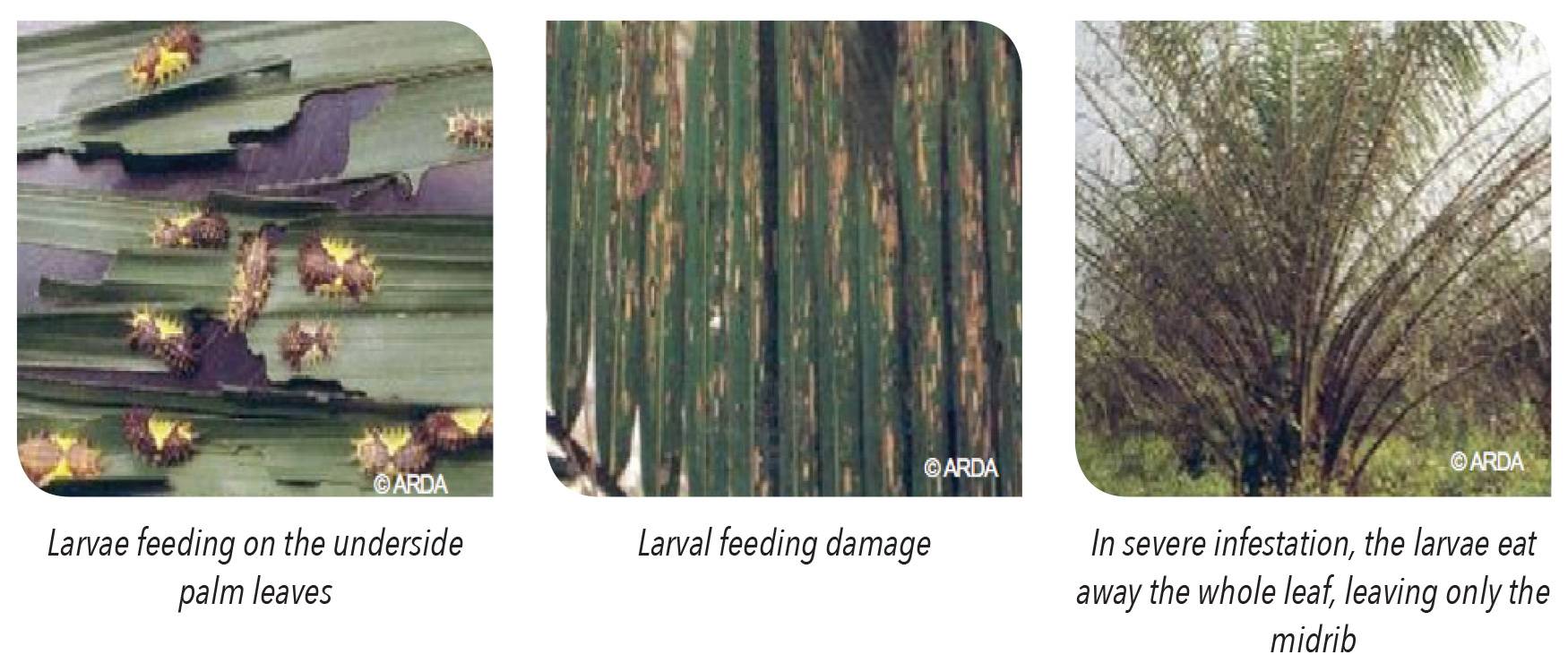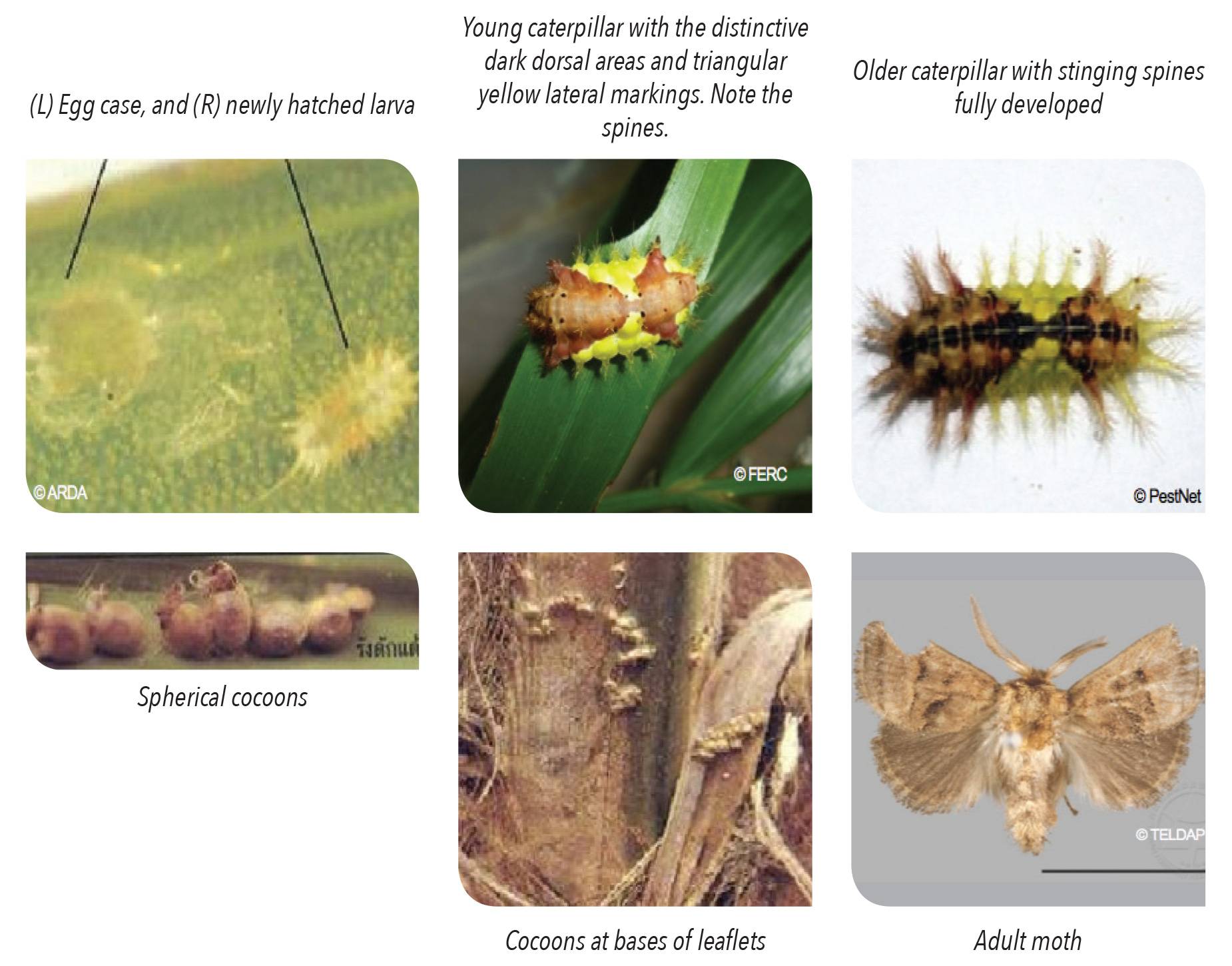General Information
The larvae or caterpillar of Darna furva causes severe defoliation on oil palm. The caterpillars usually feed on the underside of leaves. The young caterpillars often strip the leaf surface to feed, while the older caterpillars eat away the whole leaf, leaving only the midrib. The entire crown of the palm may be defoliated during severe out-breaks. Severe defoliation, particularly of the young leaves, may affect the yield of fresh fruit bunches (FFB).

In addition to palm damage, D. furva also pose health risks to infested areas. The caterpillars have stinging spines that can cause painful injury to plantation and nursery workers, and irritation (or allergies to sensitive individuals).
Outbreaks have occurred on oil palm in south Thailand (i.e. Chumphon, Surathani, Krabi Provinces) where it is considered a major pest.
Distribution
Thailand, Northeast India, China, Taiwan, Hong Kong (limited distribution), Maldives.
Detection and Inspection
ADULT MOTHS
Small moth measuring 8-10 mm in size. The wing markings are not regularly defined. The total life cycle is normally 50.3 days. An adult female moth has been observed laying 170 eggs over 2-3 days.
COCOON
Smoothly rounded and brown in colour. Cocoons measure 5-6 x 7.8 mm in size. Present in the crown and at the base
of leaflets.
LARVAE
Measure 9-10 mm long by 3.5-4 mm wide at the beginning on the final instar. The brown dorsal area is fairly uniform in full grown caterpillars, and the row of subdorsal black spots is conspicuous. The dark dorsal area is more variegated on younger caterpillars. In older caterpillars, the triangular lateral marking is yellow, but more translucent green edged with yellow in younger caterpillars. The peak of the triangular patch extends dorsal to the subdorsal scoli, reaching the subdorsal row of black spot.
EGGS
Measure 1.1 x 1.3 mm and are laid singly on the leaflet undersurface. Clear and flat in appearance. Eggs are mostly laid in the lower leaves up to leaf 17.

Prevention and Control
PHYTOSANITARY
Eggs and young larvae are difficult to detect via visual inspection. Only the larger mature larvae or adult moths are more likely to be detected. Cocoons may be contaminant in seed lots. Therefore, ensure source of germplasm from pest free areas. Proper sanitation from sourcing to shipping is crucial. The import of germplasm material (seeds, pollen, tissue culture) must be accompanied by an import permit issued by or on behalf of the Director-General of Agriculture for Peninsular Malaysia (including Labuan), or the Director of Agriculture for Sabah, and a phytosanitary certificate issued by an authorised official from the country of export. The import conditions are available upon request from the Plant Biosecurity Division Malaysia. All consignments are subjected to inspection by the Agricultural Department prior to clearance by Customs. Germplasm material imported from high risk areas should be sent for third country quarantine before arrival onto Malaysian shores. The import of alternative host plant parts i.e. Antidesma spp., Cocos nucifera and Salacca zalacca from infested areas should be enquired with DOA.
CULTURAL CONTROL AND SANITARY METHODS
Conduct regular surveillance system to detect population spikes, and destroy centers of infestation. Plantations to be inspected regularly every 2 months: fronds to be destroyed immediately upon detection of larvae.
CHEMICAL TREATMENT
Chemical insecticides like quinalphos and lambda cyhalothrin.
Further reading
- Arda (2015). Oil Palm. Url: http://www.arda.or.th/ kasetinfo/south/palm/controller/01-06.php.
- Corley, R H V and Tinker, P B (2003). The Oil Palm (4th Ed.). Blackwell Science Ltd.: USA. p. 433-434.
- Cock, M J W; Godfray, H C J and Holloway, J D (1987). Slug and nettle caterpillars: The biology, taxonomy and control of the Limacodidae of economic importance on palms in Southeast Asia: CAB International: UK. p. 104- 105.
- Forest Entomology Research Center (FERC), (2015). Life cycle of insects.
- PestNet (2015). Slug caterpillar, Darna furva, Maldives. Url: http://www.pestnet.org/Summaries of Messages Pests/ PestsEntities/Insects/Mothsbutterflies Darnafurva, slugcaterpillar,Maldives.aspx.
- Teldap (2015). Darna furva. Url: http://catalog. digitalarchives.tw/item/00/45/f4/dc.html.

